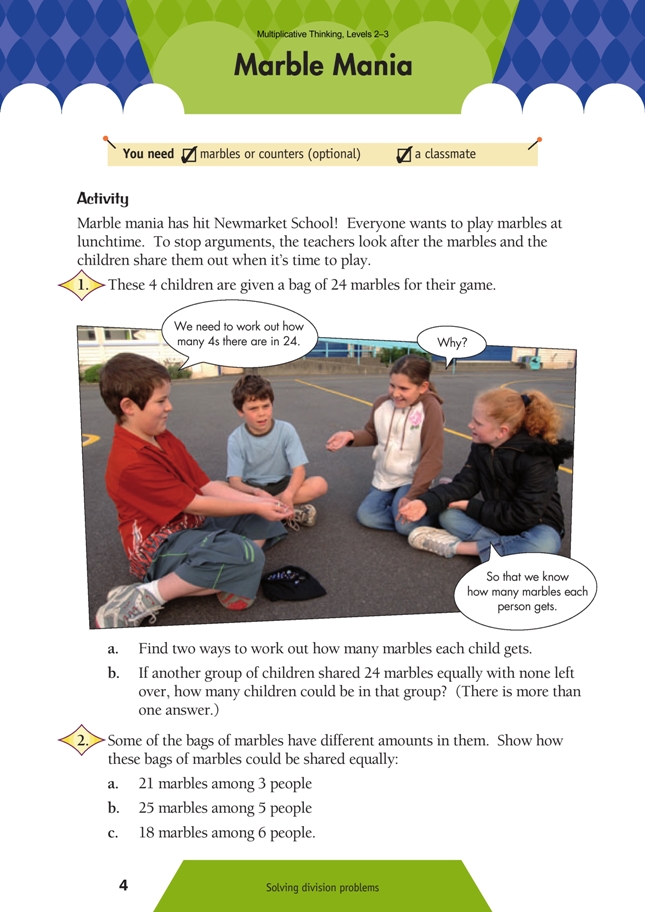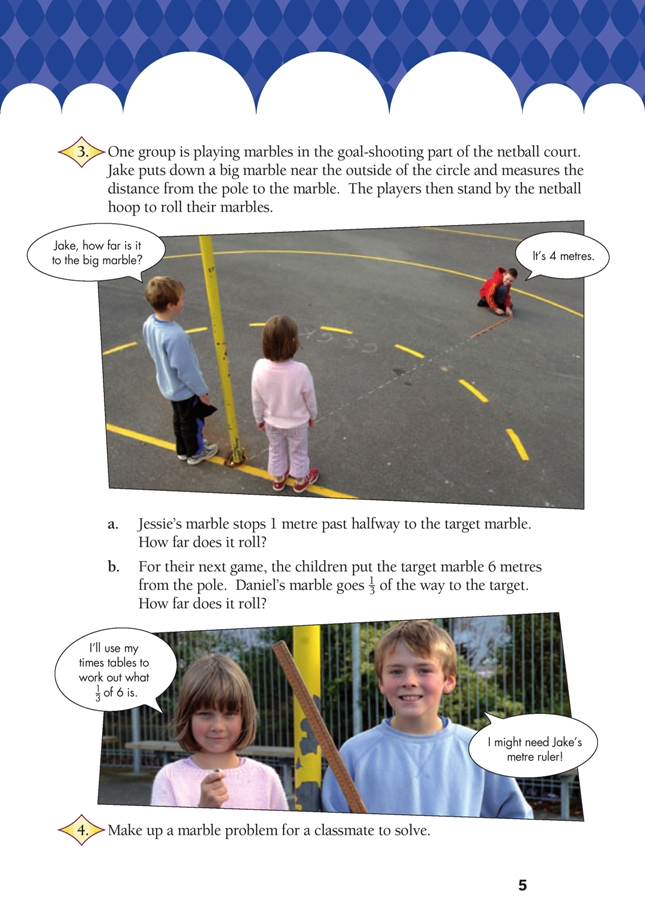This is a level 2 number activity from the Figure It Out series. It relates to Stage 5 of the Number Framework.
A PDF of the student activity is included.
Click on the image to enlarge it. Click again to close. Download PDF (669 KB)
solve division problems by sharing
Number Framework Links
The use of numbers within the basic facts range makes this activity appropriate for students at stage 4 to solve in a guided group and for students at stage 5 to attempt with some guidance. Students at stage 6 should be able to complete this independently.
Marbles or counters (optional)
FIO, Levels 2-3, Multiplicative Thinking, Marble Mania, pages 4-5
A classmate
This activity uses marbles, a game with which most students are familiar, as a context for division problems. It presents the two types of division problem: sharing division and measurement division (see page 5 of Numeracy Development Project Book 6: Teaching Multiplication and Division). In sharing, discrete objects are shared out into a number of groups (for example, biscuits into packets). In measurement division, continuous amounts are divided into equal parts (for example, fabric into lengths). In this activity, the students share the marbles and then look at dividing metre lengths.
The students in your class may find the discrete sharing problems easier to conceptualise and solve than the measurement problems. Both problem types can be solved using concrete models to aid understanding. Remember to encourage students to apply the number facts they know to these problems to develop the use of number properties.
For question 1a, share the methods that the students devise. Make a shared record and discuss the different strategies. Which do you think is the “smartest” way to solve this problem? Encourage the students who are using addition or subtraction to explain the multiplication/division methods that others may have used.
For part b, challenge the students to look for a pattern and to organise their answers in a way that shows that they know they have found all the possibilities. This leads to a worthwhile discussion of how we know we have found all the factors of a number. Although students at this stage will not be able to form an abstract generalisation for this, they will be able to explore aspects of it. For example, using a Happy Hundreds sheet (Material Master 6-5) or counters, the students can make rectangles that have 24 objects in them; the sides will then be factors. Encourage them to be systematic: Can you make a rectangle that uses all 24 counters in rows? Which rectangle has a side of 2 counters? 3 counters? When you get to 6, prompt the students to see how many counters are on the other side. If they record the equations, they will see a pattern and can predict what other pairs may be left.
Question 2 is a sharing problem that can be modelled if necessary. Encourage the students to explore how they can use what they know to help them solve the problem, for example, “I know that if it was 3 marbles for 3 people, we would need 9 marbles, so it’s more than 3 …”
Question 3 involves measurement division. For 3a, the students need to partition a continuous 4 metre length. They may need to make a 4 metre length (or a scale model of that length), which they could then fold and label, using sticky-backed notes to give them reference points. Again, draw links between the mathematics of this question and facts that the students know. For 3b, emphasise the connection between 3 twos in 6 and one-third of 6 being 2. These two expressions mean the same thing in this context but often become disconnected in students’ thinking.
For question 4, see the suggestions in Party to the Max about helping students to write problems. They may tend to write addition problems or subtractions such as “I lost some marbles.” Use containers or pieces of cardboard to represent bags of marbles and get them to write a problem that matches the bag of marbles you have modelled.
Answers to Activity
1. a. Each child gets 6 marbles. Possible methods include using counters or drawing the marbles and separating them into groups; counting on and multiplication
(4 + 4 + 4 + 4 + 4 + 4 = 24, 6 x 4 = 24);
subtraction and multiplication
(24 – 4 – 4 – 4 – 4 – 4 – 4 = 0, 6 x 4 = 24);
multiplication (4 x ? = 24); or division
(24 ÷ 4 = 6).
b. Possible groups are: 2, 3, 4, 6, 8, or 12 children. A group of 24 children is also
possible, although they would get only 1 marble each.
2. Methods will vary. Possible answers include:
a. 7 marbles each. Sharing out the marbles in groups of 3 gives: 3 + 3 + 3 + 3 + 3 + 3 + 3 = 21, that is, 7 x 3 = 21; or 21 – 3 – 3 – 3 – 3 – 3 – 3 – 3 = 0, 7 x 3 = 21;
or 3 x ? = 21; 21 ÷ 3 = 7
b. 5 marbles each: 5 + 5 + 5 + 5 + 5 = 25, 5 x 5 = 25; 25 – 5 – 5 – 5 – 5 – 5 = 0,
5 x 5 = 25; 5 x ?= 25; 25 ÷ 5 = 5

